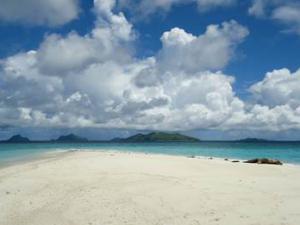Happy World Oceans Day! Preserving marine biodiversity in developing countries: the role of Marine Protected Areas
Discussion details
Article contributed by Rocio Suarez-Jimenez
The sea covers more than 70% of the earth's surface and the diverse life within it contributes greatly to human wellbeing by providing ecosystems services (e.g. 70% of the oxygen we breathe, climate regulation) and living resources (e.g. fish) upon which we depend. Marine ecosystems are however facing unprecedented biodiversity loss globally as a result of habitat destruction, pollution, invasive species, overfishing and climate change. Around 400 marine species are (critically) endangered, 20% of coral reefs are lost, 50% of mangrove cover and 30% of seagrass habitats have disappeared (representing > 10% of global carbon emissions through deforestation), and nearly 70% of the world's fish stocks are either fully exploited, overfished or depleted. The loss of marine ecosystem services resulting from biodiversity loss specially affects coastal communities in developing countries, since marine resource exploitation often represents their livelihoods, main source of animal protein and cultural identity.

Marine Protected Area, Thailand. Photo ⓒ Rocio Suarez-Jimenez
Preserving marine biodiversity is therefore a major concern worldwide. The UN urges countries to preserve marine biodiversity through the CBD's Strategic Plan for Biodiversity 2011-2020 (Aichi targets [1]), the implementation of the Regional Seas Programme, or the FAO Code of Conduct for Responsible Fisheries [2]. One of the main challenges relies on the fact that many marine biodiversity hotspots (i.e. areas that have large numbers of endemic species and are heavily threatened by habitat loss) are in developing tropical and subtropical countries (e.g. Coral Triangle, Southwest Indian Ocean, Western Pacific Ocean), where intrinsic structural weaknesses and limited resources undermine effectiveness in preventing and reversing biodiversity loss, and international aid is often required to meet with proposed recommendations. Conservation of marine resources is however recognised as key for the sustainable development of coastal communities in poor countries (particularly addressed through Sustainable Development Goal #14).
Marine Protected Areas (MPAs) have gained international consensus for marine biodiversity conservation and restoration. Whether they are national parks, natural heritage sites, sanctuaries, allow resource extraction or forbid it completely (e.g. no-take or reserve), they intend to provide protection according to the conservation status and biodiversity value of an area. In developing countries, MPAs are widely recognised as a tool to provide food security and build resilience against climate change impacts such as coastal erosion, for which they are particularly vulnerable. Reality however shows that lack of economic and human resources challenges the creation, enforcement, monitoring and control of MPAs in there. Fortunately, experience demonstrates that the right technical and financial support can turn MPAs implementation in fruitful stories. If properly designed and managed MPAs have shown to protect ecosystems and help replenish resources, rising productivity by fourfold, and bring well-being, livelihoods (e.g. improved fisheries), new economic opportunities (e.g. sustainable tourism), jobs and a stronger sense of connection and ownership (e.g. community-managed MPAs) to communities. These benefits still increase when supported by adequate and well integrated MPA networks.
The international community acknowledges that, with just over 2% of our oceans currently protected and many MPAs suffering from poor management, there is still a long way to go. For its part, the EU is financing the Biodiversity and Protected Areas Management Programme (BIOPAMA) through the 10th EDF managed by DEVCO C2. Jointly implemented by IUCN (capacity building) and EC-Joint Research Centre (improving access and availability of biodiversity data), the programme has setup regional observatories for protected areas (including MPAs) and biodiversity in ACP countries.

Marine Protected Area, Fiji. Photo ⓒ Rocio Suarez-Jimenez
Under the GPGC budget, the EU is also supporting several projects in MPAs: (i) support to MPAs and sustainable fisheries in greater Caribbean landscape (on-going call for proposals for 8.5 million EUR), (ii) Critical Ecosystem Partnership Fund working in hot spots of biodiversity, and (iii) BEST 2.0 supporting biodiversity activities in Overseas Countries and Territories. In addition, several strategic studies for marine biodiversity conservation in Africa and Asia are being currently developed by the European Commission's Development & Cooperation (DEVCO), and will highlight the creation and better management of MPAs as priority actions, under the framework of the Biodiversity for Life (B4Life) flagship initiative and further promoted through capacity4dev.
Supporting MPAs in developing countries will allow the EU to not only comply with international commitments towards marine conservation biodiversity, but also with the Sustainable Development Agenda for 2030 and the Paris Agreement on Climate Change. In particular, seagrass meadows and mangrove forests are amongst the most powerful carbon sinks of the world’s ecosystems. EU investments in MPAs also contribute to our international commitments to climate finance (20% of the overall budget must be climate-relevant) and biodiversity finance (doubling biodiversity-relevant funding with regard to the 2006-2010 average).
The challenges ahead require a global commitment to reverse the loss of marine biodiversity urgently. We know much less about the ocean than about land ecosystems and this has translated into relatively delayed conservation science and actions. It is not too late, though. We simply need to look back and around for successful examples and use those to create the momentum to improve our contribution to preserve and restore marine biodiversity, for the present and future sustainability of the environment and human development.
[1] https://www.cbd.int/sp/targets/
[2] http://www.fao.org/docrep/005/v9878e/v9878e00.htm

Log in with your EU Login account to post or comment on the platform.